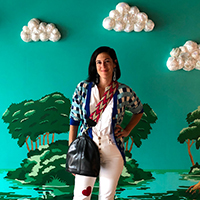Erica Rosenfeld

Erica Rosenfeld began beading when she was five and came to glass in her early twenties. The jewelry and sculpture that she creates stem from the ritualistic nature of her childhood art. There are many technical, stylistic, and thematic connections Erica finds between her functional and sculptural work. She uses multiple processes to make components that she then sews together with beads to make labor-intensive kinetic jewelry and wall tapestries. She has been teaching glass fusing and glass roll-ups at Urban Glass in Brooklyn, NY (where she also uses the studio) and other glass and craft institutions. She is mostly self-taught; has been a T.A. for Klaus Moje and Scott Chaseling. Her work has been featured in various publications including “New Glass Review,” “Glass Magazine,” “New York Magazine,” “In Style,” and “Glashaus”. Selected galleries include Heller Gallery, NY; Sienna Gallery, MA; Morgan Contemporary Glass, PA and Snyderman-Works Gallery, PA.
One of the founding members of the Burnt Asphalt Family and frequent resident artist of many glass art institutions, Erica Rosenfeld’s work celebrates the history of glassmaking, material culture, and craft. Rosenfeld’s work meets at the crossroad between art and craft, often playing with the demonstrative aspect of glassmaking and cooking as both labor-intensive cultural crafts. As a member of the Burnt Asphalt Family, Rosenfeld has performed at the Corning Museum of Glass and the Chrysler Museum of Art. Rosenfeld has been a glass instructor at Pilchuck, UrbanGlass, and Corning. Her work has also been exhibited at various museums and galleries such as the Museum of Arts and Design in New York, John Michael Kohler Arts Center, and the Museum of American Glass at WheatonArts.
50th Anniversary Visiting Artists
A Creative Glass fellowship participant in 2007, 2011, and 2017, Rosenfeld chose to display eight pieces of her series Strange Creatures Portraits. These pieces depict animals in colorful displays with 3D glass elements. The compositions mimic 1950s kitsch culture but also are modeled after traditional European portraiture. Rosenfeld takes inspiration from the Paint By Number kit, which was created in the 1950s. The kit expressed creativity conformity by following the instructions while the socio-political climate at the time mirrored the desire for a uniform society. Here Rosenfeld connects material culture and social commentary in a mixed media series that incorporates the craft of glass.

